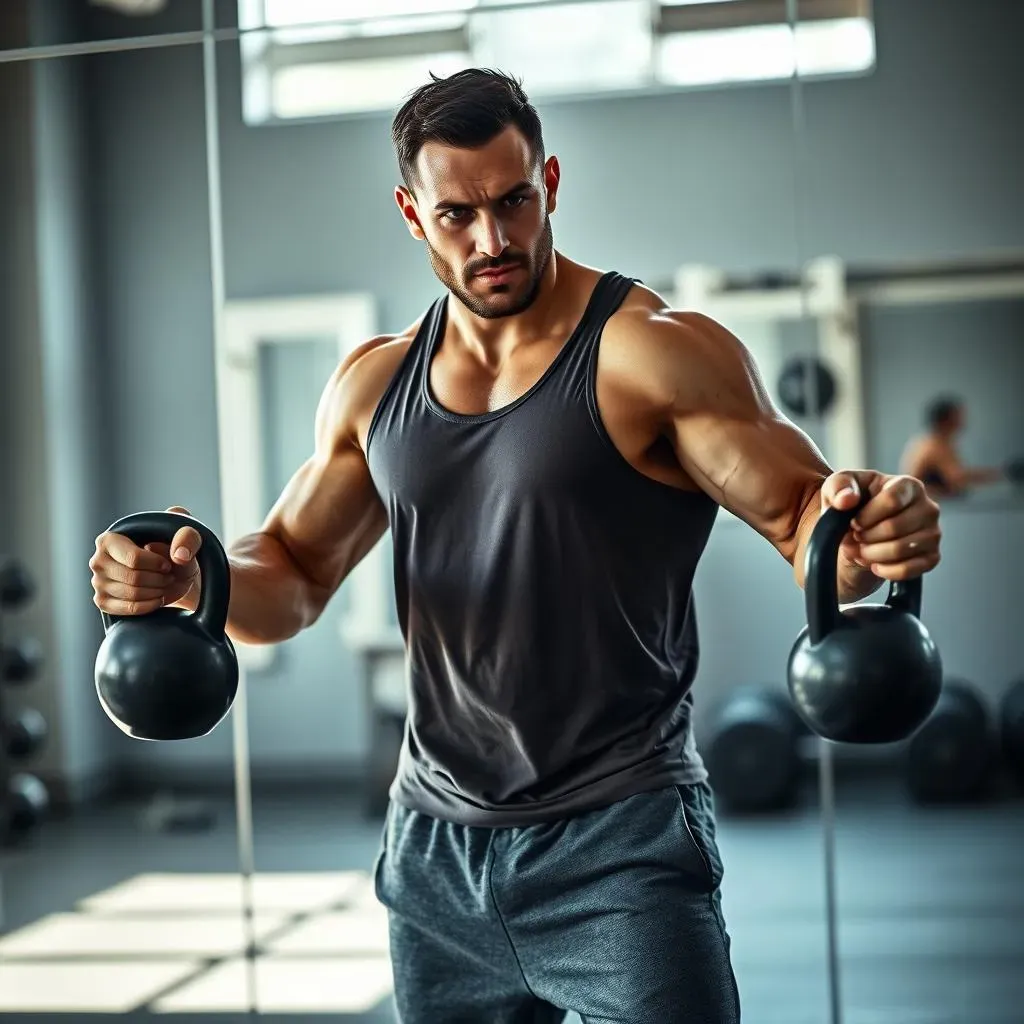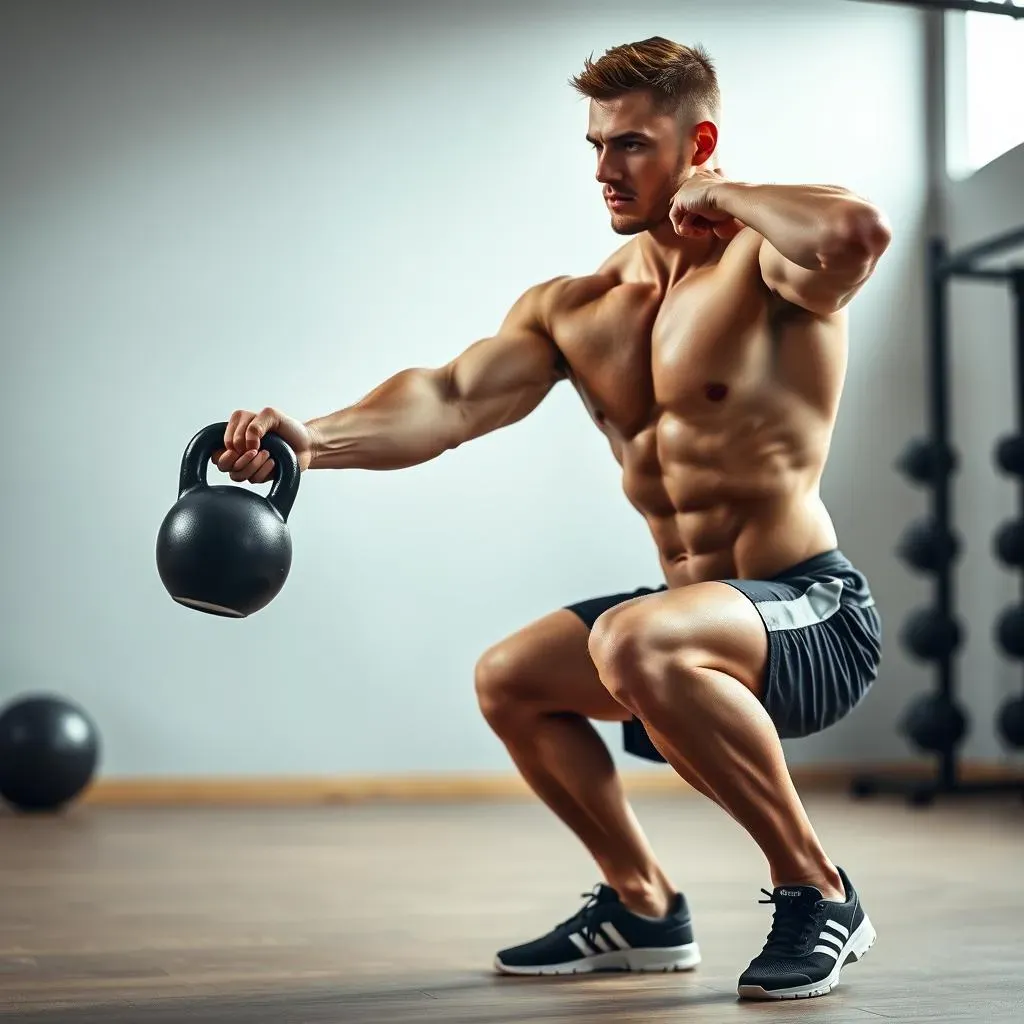Table of Contents
Bicep workouts with kettlebells? Yeah, we're not talking about your grandma's dumbbell curls here. If you're stuck in a bicep rut, those old-school curls aren't cutting it anymore. It's time to shake things up with kettlebells. These cannonballs with handles aren't just for swings and squats. They're secretly amazing for building serious bicep strength and size, I mean who doesn't want bigger biceps? This article is your guide to ditching the predictable and diving into six unique kettlebell exercises that will challenge your biceps like never before. We're going to explore movements that not only build muscle but also improve your grip, stability, and overall strength. Prepare to experience constant tension, simultaneous stretching and overload, and a whole new level of bicep pump. So, grab a kettlebell, and let's get to work, it's time to get those guns firing.
Standing Kettlebell Curls: The Foundation

Standing Kettlebell Curls: The Foundation
Alright, let's talk about the bread and butter of kettlebell bicep work: the standing curl. It might sound basic, but trust me, there's nothing "basic" about how these hit your biceps. Unlike dumbbells, the kettlebell's weight hangs below your hand, creating a unique challenge. This positioning forces your forearms and biceps to work overtime to stabilize the weight throughout the entire curl. You're not just lifting; you're controlling, engaging, and basically making your muscles scream "uncle" in the best way possible.
The magic of the standing kettlebell curl is in its constant tension. You know how sometimes with dumbbells you can get a little cheat-y? Swinging a bit? Yeah, kettlebells aren't having any of that nonsense. The offset weight makes it harder to cheat, forcing you to maintain proper form and really isolate your biceps. It's like the kettlebell is saying, "Oh, you want to curl? but you're going to do it *right*."
Benefit | Description |
|---|---|
Constant Tension | Weight hangs below the hand, forcing continuous muscle engagement |
Reduced Cheating | Offset weight makes it harder to swing or use momentum |
Improved Stabilization | Forearms and biceps work to control the kettlebell |
Incline Kettlebell Curls: Stretch and Overload

Incline Kettlebell Curls: Stretch and Overload
Setting the Stage for Growth
now we're getting into the good stuff. Incline kettlebell curls are where things get seriously interesting. Forget just lifting; we're talking about maximizing muscle growth through a killer combination of stretch and overload. Think of it like this: you're not just curling, you're creating an environment where your biceps are begging to grow. By positioning yourself on an incline bench, you're putting your biceps in a stretched position at the bottom of the curl.
That stretch? It's not just for show. It actually allows for greater muscle fiber activation, which means more muscle damage, which then results in more growth. It's like you're setting your biceps up for a controlled explosion. And then, as you curl the kettlebell up, you're hitting them with a load that feels heavier because of the angle. It's a double whammy of growth-inducing goodness.
Why the Incline Matters
The incline isn't just about looking fancy; it's about maximizing the effectiveness of the curl. It shifts the emphasis to the long head of your biceps, which is the part that gives your arms that peak. The long head is often neglected in regular curls, making incline curls a great way to target it specifically. You're essentially working your biceps through a greater range of motion, making every rep count.
Plus, the instability of the kettlebell on an incline adds an extra challenge. You have to engage your core and shoulder stabilizers to keep the weight steady. It's not just a bicep workout; it's a whole-body engagement. I mean, who doesn't love a workout that hits multiple muscles at once? This movement is a great example of getting more bang for your buck.
Benefit | Description |
|---|---|
Targeted Muscle Activation | Emphasizes the long head of the biceps for a better peak |
Increased Range of Motion | Works the biceps through a greater range of movement |
Core Engagement | Requires core and shoulder stabilizer activation for balance |
The Overload Advantage
Now, let's talk about the "overload" part of the equation. The incline position makes the kettlebell feel heavier at the bottom of the curl, which means your biceps have to work harder to initiate the movement. This added difficulty creates more micro-tears in the muscle fibers, which are essential for growth. It's like you're putting your biceps under a controlled amount of stress, forcing them to adapt and become stronger.
So, if you're looking to take your bicep game to the next level, incline kettlebell curls are a must. They're not just another curl variation; they're a strategic way to maximize muscle growth by combining stretch, overload, and targeted muscle activation. Remember, it's not about how many reps you can do, it's about how effectively you can work your muscles.
Kettlebell Hammer Curls: Forearm Power

Kettlebell Hammer Curls: Forearm Power
Grip It and Rip It
so you've been hitting those bicep curls, feeling the burn, but are you really working your forearms? That's where kettlebell hammer curls come in. They're not just a bicep exercise; they're a forearm party! The neutral grip, where your palms face each other, shifts the focus away from the peak of the bicep and onto the brachialis muscle, which sits underneath the bicep. This gives your arms that thick, powerful look. Plus, it's seriously going to test your grip strength.
The kettlebell's offset weight adds an extra challenge here too. It's not like a dumbbell where the weight is evenly distributed. With a kettlebell, you're constantly fighting to keep it stable, which means your forearms are getting a serious workout. Think of it like this: you're not just curling; you're wrestling with the kettlebell, and your forearms are the referee.
More Than Just Biceps
You might be thinking, "Why should I care about my forearms?" Well, strong forearms aren't just for show. They're essential for everyday tasks, from carrying groceries to opening jars. And let's be honest, a good handshake with a strong grip makes a statement. Kettlebell hammer curls are a practical way to build functional strength that goes beyond just aesthetics.
The beauty of the hammer curl is that it targets muscles that are often neglected in traditional bicep workouts. By working the brachialis and the muscles in your forearms, you're creating a more balanced and powerful upper arm. It's like you're building a complete arm, not just a bicep. And let's be real, a well-rounded arm is a strong arm.
Benefit | Description |
|---|---|
Brachialis Activation | Works the muscle beneath the bicep for a thicker arm |
Forearm Strength | Improves grip and overall forearm power |
Functional Strength | Builds practical strength for everyday tasks |
The Tension is Real
Now, you might need to drop the weight a bit for these. Don't go thinking you can use the same weight you use for standard curls. The unique loading of the kettlebell and the neutral grip make it much more demanding. You'll notice that the weight feels heavier, especially as you get to the top of the movement. This is where the tension really peaks.
But that's a good thing. The increased tension means your muscles are working harder and are getting more stimulation. It's like you're squeezing every last drop of effort out of your arms. So, if you're looking for a bicep exercise that also packs a punch for your forearms, kettlebell hammer curls are the way to go. They're a fantastic way to add variety to your routine and build some serious arm power.
Kneeling Alternate Kettlebell Curls: Strict Tension

Kneeling Alternate Kettlebell Curls: Strict Tension
Form Over Everything
so you've nailed the standing curls, you've stretched it out with the inclines, and you've powered up those forearms with hammer curls. Now, let's talk about the kneeling alternate kettlebell curl. This isn't just about lifting; it's about control, focus, and squeezing every bit of tension out of your biceps. The kneeling position is key here. It eliminates a lot of the momentum you might get from standing, forcing you to rely entirely on your bicep strength. It's like the exercise is saying, "No cheating, just pure, unadulterated bicep power."
The alternate part? It means you're curling one arm at a time. This helps you focus on each bicep individually, making sure you're not compensating with one side over the other. It's like giving each bicep its own personal training session. And because you're starting from a contracted position, you're forcing your biceps to work harder right from the get-go. There's no swinging, no momentum, just pure, controlled movement that will leave your biceps begging for mercy.
The Tension Advantage
You know how sometimes at the top of the curl, you can kind of "rest" for a second? Yeah, not here. The kneeling position and the alternate movement ensure that your biceps are under constant tension throughout the entire range of motion. It's like your biceps are trapped in a never-ending squeeze. This continuous tension is what's going to lead to serious muscle growth. It's all about maximizing the time your muscles are under stress, and this exercise is a masterclass in that.
And because you're alternating arms, you're not just working your biceps; you're also engaging your core to stay stable. It's like a sneaky little core workout disguised as a bicep exercise. The reduced momentum and focus on control mean you're not going to be able to use as much weight, and that is okay. It's about quality, not quantity. It's about feeling the muscle work and pushing it to its limit.
Benefit | Description |
|---|---|
Reduced Momentum | Kneeling position eliminates swinging, forcing strict form |
Continuous Tension | Biceps are under constant stress throughout the movement |
Individual Focus | Alternating arms ensures even muscle development |
Isolateral Kettlebell Squat and Curl: Full Body Engagement

Isolateral Kettlebell Squat and Curl: Full Body Engagement
More Than Just a Bicep Move
so we've hit the biceps from every angle, but what if I told you that you could work your legs, core, and biceps all at once? Enter the isolateral kettlebell squat and curl. This isn't just a bicep exercise; it's a full-body symphony that’ll make you feel like a superhero. You start with a squat, engaging your quads, glutes, and core, then as you stand, you curl the kettlebell up. It's like a dance, a beautiful, muscle-building dance. The "isolateral" part means you're working one side of your body at a time, which throws in a balance challenge that your core will love.
It's not about just lifting the weight; it's about coordinating multiple movements at once. You're squatting, you're curling, you're balancing, you're engaging all sorts of muscles you didn't even know you had. The kettlebell, hanging off to one side, creates a constant pull that your core has to fight against to keep you upright. It's like your body is saying, " I see what you're doing, I'm going to work extra hard to keep you from falling over!" This exercise is a testament to how interconnected our body is, and how we can get more efficient with our training.
Benefit | Description |
|---|---|
Full Body Workout | Engages biceps, legs, and core simultaneously |
Balance Challenge | Isolateral movement improves core stability |
Coordination | Requires multiple movements to be executed at once |
Reverse BottomsUp Biceps Curls with Kettlebells: Shoulder Stability

Reverse BottomsUp Biceps Curls with Kettlebells: Shoulder Stability
The Shoulder Saver
Alright, let’s talk about the unsung hero of bicep curls: the reverse bottoms-up kettlebell curl. This isn't your average curl; it's like a secret weapon for shoulder health and bicep growth. The "bottoms-up" part is key here. You're holding the kettlebell upside down, with the weight above your hand, which immediately changes everything. This position forces you to engage your shoulder stabilizers and rotator cuff muscles like never before. It's like your shoulders are getting a mini workout just from holding the kettlebell in place.
The reverse grip, with your palms facing down, also shifts the emphasis on your biceps. It targets the brachialis and brachioradialis muscles, which are often neglected in traditional curls. Plus, the instability of the kettlebell in this position makes it seriously challenging to control. You're not just curling; you're balancing, stabilizing, and making sure that kettlebell doesn't take a dive. It's a great way to get your shoulders strong and stable while building those biceps.
Benefit | Description |
|---|---|
Shoulder Stability | Engages rotator cuff muscles for improved joint health |
Muscle Activation | Targets brachialis and brachioradialis muscles |
Improved Grip | Requires a strong grip to control the kettlebell |
Posture Perfect
You know how sometimes when you do regular curls, your shoulders tend to creep up towards your ears? Yeah, that's a big no-no. It means your traps are taking over, and your shoulders are in a compromised position. The reverse bottoms-up curl helps you fix that. By forcing you to stabilize the kettlebell, it promotes optimal shoulder positioning and postural alignment. It's like your body is saying, "Finally, some good shoulder posture!"
And because you have to be so focused on controlling the kettlebell, you automatically reduce the possibility of excessive shoulder involvement. You're not just lifting the weight; you're actively engaging the muscles that keep your shoulder joint healthy and happy. It's like your body is getting a lesson in proper form with each rep. This exercise is a great example of how you can build your biceps and improve your overall posture at the same time.
Wrapping Up Your Kettlebell Bicep Journey
So, there you have it – six killer kettlebell exercises to blast your biceps. We’ve gone way beyond the basic curl, exploring movements that challenge your muscles in new and exciting ways. Remember, it’s not just about lifting heavy; it’s about lifting smart. Focus on maintaining proper form, controlling the weight, and really feeling the tension in your biceps. These workouts are designed to not only build muscle, but also to improve your overall functional strength. So, ditch the predictable routines, grab your kettlebells, and get ready to unleash some serious arm gains. These bicep workouts with kettlebells are a game-changer, trust me. Now go on, get those biceps growing!